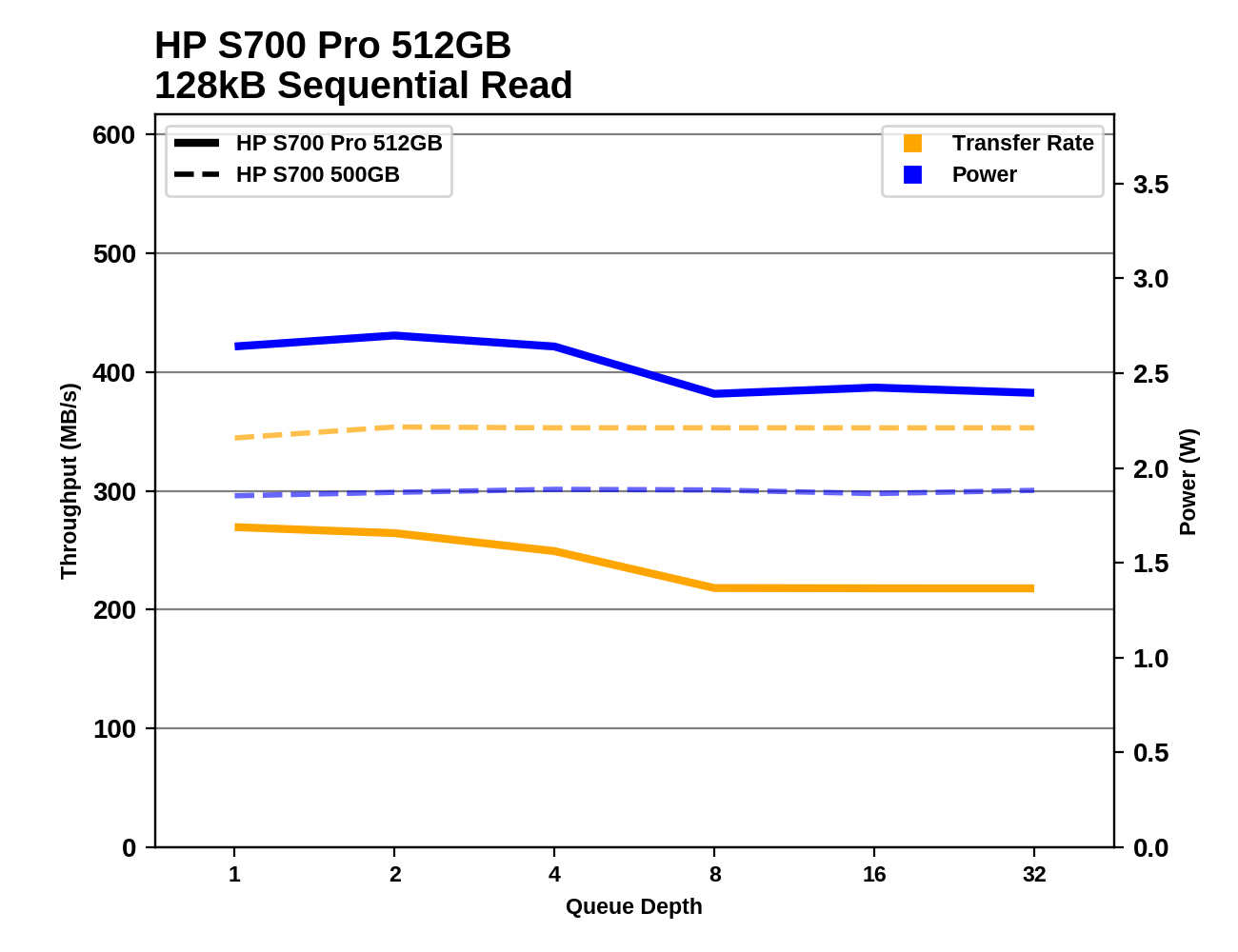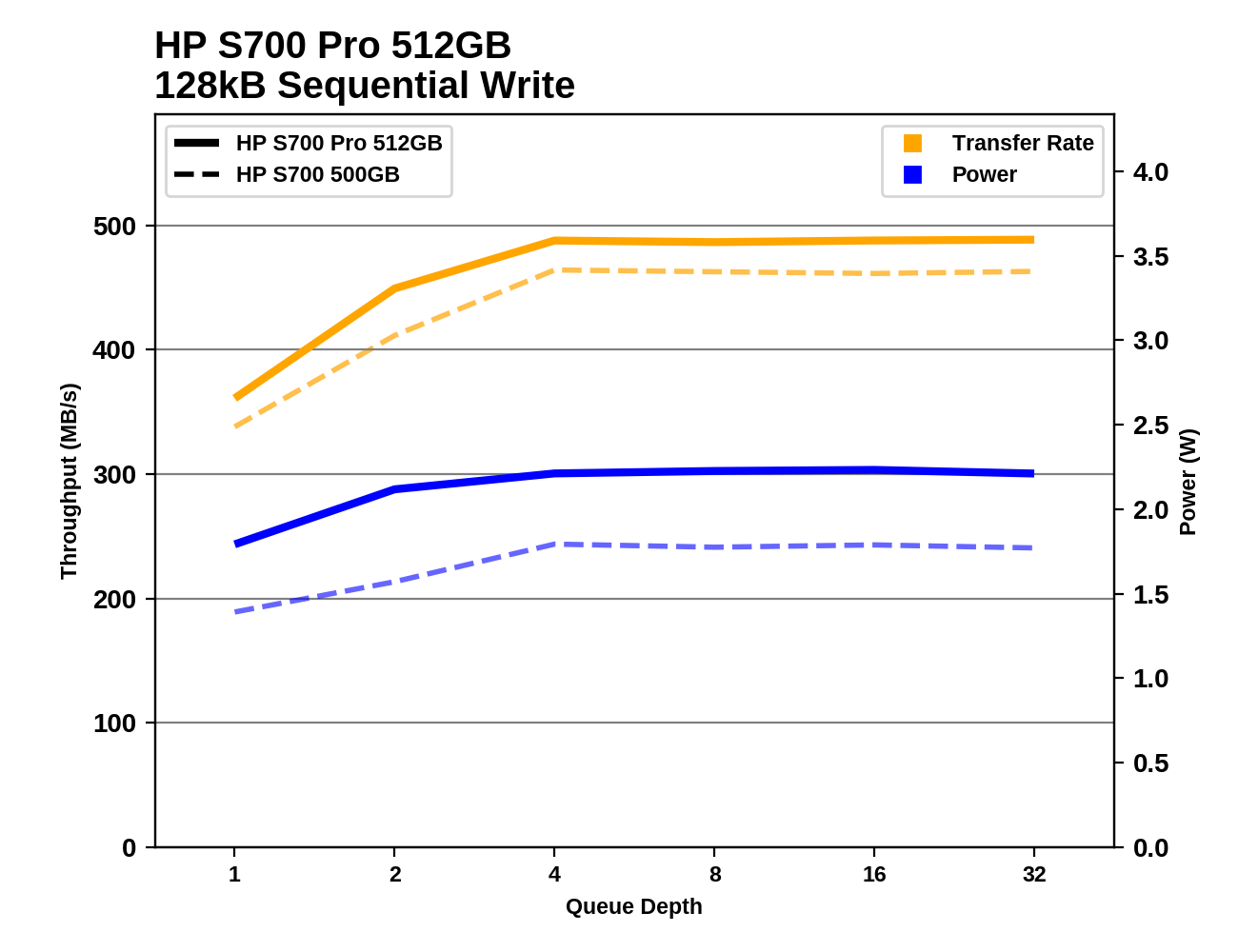The HP S700 And S700 Pro SSD Review
by Billy Tallis on September 7, 2017 9:00 AM ESTSequential Read Performance
Our first test of sequential read performance uses short bursts of 128MB, issued as 128kB operations with no queuing. The test averages performance across eight bursts for a total of 1GB of data transferred from a drive containing 16GB of data. Between each burst the drive is given enough idle time to keep the overall duty cycle at 20%.

The S700 and the larger two S700 Pros have great burst sequential read speeds, while the smallest S700 Pro has a bit of trouble (but still manages to outperform the smallest ADATA SU800 by 27%).
Our test of sustained sequential reads uses queue depths from 1 to 32, with the performance and power scores computed as the average of QD1, QD2 and QD4. Each queue depth is tested for up to one minute or 32GB transferred, from a drive containing 64GB of data.

On the longer sequential read test, the S700 doesn't drop to the bottom of the chart and instead offers above-average performance. The S700 actually has the fastest low queue depth sequential read speeds of any SATA SSD with Micron's 32L 3D NAND, including the MLC-based Crucial BX300. The S700 Pro is far slower and only its 128GB model beats the comparable ADATA SU800. We've asked HP if they can shed some light on how the S700 manages to deliver such an outstanding sequential read speed, because this is a very surprising result.

With good performance by TLC standards combined with the low power draw of a DRAMless Silicon Motion controller, the HP S700's power efficiency during sequential reads is great. The S700 Pro is near the bottom of the chart, but is a clear improvement over the ADATA SU800.
 |
|||||||||
Only a few drives have trouble delivering full performance for sequential accesses at QD1, and the HPs aren't on that list. The S700's performance is both higher and more stable across the test than the S700 Pro.
Sequential Write Performance
Our test of sequential write burst performance is structured identically to the sequential read burst performance test save for the direction of the data transfer. Each burst writes 128MB as 128kB operations issued at QD1, for a total of 1GB of data written to a drive containing 16GB of data.

The HP S700 is just a bit slower than average for burst sequential write speed, and the S700 Pro is right around the average. The Crucial MX300 and the smallest ADATA SU800 are the only real outliers on this test.
Our test of sustained sequential writes is structured identically to our sustained sequential read test, save for the direction of the data transfers. Queue depths range from 1 to 32 and each queue depth is tested for up to one minute or 32GB, followed by up to one minute of idle time for the drive to cool off and perform garbage collection. The test is confined to a 64GB span of the drive.

The longer sequential write test shows that the 120/128GB class drives are at a significant disadvantage, but the S700 Pro performs well among that cohort. The larger S700 and S700 Pro drives all offer decent sustained sequential write speeds and rank quite a bit higher than for the shorter sequential write test.

The larger two S700s join the OCZ VX500 at the top of the efficiency chart for sequential writes, and the larger S700 Pros aren't far behind. The smallest S700 Pro is far less efficient than its larger siblings, but offers 60% higher performance per watt than the ADATA SU800 and is in the top of its class (again, not counting the discontinued Samsung drives). The 120GB S700 has the lowest efficiency.
 |
|||||||||
The 500/512GB HP drives and the 250GB HP S700 don't saturate until QD4, while the 256GB S700 Pro manages to saturate at QD2. The 128GB S700 Pro runs out of spare area while the test is at QD2, so it never comes close to sustaining a speed that saturates the SATA link. The 120GB S700's performance is relatively consistent and increases somewhat with queue depth, but is overall still quite slow.










54 Comments
View All Comments
ddriver - Thursday, September 7, 2017 - link
1.1 - SATA is OK for most tasks, there will be no perceivable difference to a NVME. Besides some NVME drives are almost as slow as SATA drives, such as the p600.1.2 - most boards come with a single M2, those that have more are very expensive, and require expensive CPUs to get actual PCIE lanes
2 - because HP is paying
ddriver - Thursday, September 7, 2017 - link
Even the most expensive mobos have at most 3 m2 slots, so if you want more than 3 SSDs, what do you do then? In contrast, even low end mobos come with at least 4 SATA ports.You can get some very decent speed from SSDs in raid 0, on top of the higher capacity, SATA ssds go as high as 4TB, m2 cap out at 2TB.
8steve8 - Thursday, September 7, 2017 - link
sure, but do you think most people who can't afford a higher end motherboard are buying more than one SSD for their system?ddriver - Friday, September 8, 2017 - link
It depends on what you need. You can save plenty on money on mobo and cpu and spend on much affordable sata ssds. Just because you may need to spend 1000$ on storage doesn't mean you have to be forced to spend another 1000 on cpu and mobo.A 2 TB evo will cost you 700$, the cheapest and "onlinest" 2TB m2 drive is 1200$ - over 70% more expensive. The mx300 is even cheaper - you can have a full 4 TB for less than 1200$.
yankeeDDL - Thursday, September 7, 2017 - link
Loads of people. I have 3 SATA SSD on my PC and 2 laptops.M.2 is still much pricier, so only premium laptop use them, and I find it easier to buy a laptop with a regular HDD, and upgrade it to the SSD of my liking and size. SSD still carry a huge markup on many laptops, and in many cases you cannot even select one which is bigger than 128GB, which is preposterous.
sonny73n - Friday, September 8, 2017 - link
I am still buying SATA SSDs for my OCed Sandy Bridge system. Have 3 SSDs in there but I'm considering a big one for storage.evilspoons - Sunday, September 10, 2017 - link
Yep, I've got a friggin GTX 1080 in my i7-2600k and a random collection of hard drives and SSDs populating pretty much every SATA port on my ASUS P8Z68-V PRO. M.2? Neato, but... what's that? Lol.Up next, I would not mind a nice ol' 2 TB SSD to put the majority of my Steam games on, but I really don't have $1400 CAD to special order an 850 Pro (or Evo). Both of which are SATA, good luck with anything over M.2... I think the 960 Pro is like $1700 CAD?
mapesdhs - Wednesday, September 13, 2017 - link
To the both of you, just use an SM951 or SM961 on a PCIe adapter card. I get very good results with either model on my ASUS M4E, am about to move my main photo/video archive from a 500GB 850 EVO onto a 512GB SM961. I'm getting around 2GB/sec with the SM951, 3GB/sec with the SM961, and even more with SB-E mbds (3.5GB/sec on an R4E). In the UK where I am, the Akasa PCIe adapter card is only about 13 UKP, so the total cost is still less than mainstream SATA SSDs, though I did manage to get a 960 Pro 512GB for a good price for my R4E gaming setup.Also, the 950 Pro has its own boot ROM, so on older mbds you can use it as a boot drive via legacy BIOS settings. I know someone who's done this with their X79 and I plan on doing it with my own setups. Alas the 960 Pro does not have its own boot ROM so it can't be used in the same way by default. Other NVMe models also have their own boot ROM though, such as the Intel 750.
Also, for ASUS X79 systems, there's a thread on the ROG site where a guy is posting modded BIOS files to allow various ASUS mbds to boot from any NVMe SSD, not just units like the 950 Pro. Thus, I plan on replacing my R4E's 850 Pro with a 960 Pro which was originally going to be just for game data alone.
There's still plenty of life left in older mbds, much to the annoyance I'm sure of Intel and other vendors. :D Beats me though why Samsung didn't include a boot ROM in the 960, that was bizarre.
PM/email me if you'd like screen captures of these SSDs being tested on various configs (so far mostly an M4E, R4E ans P9X79-E WS), ie. AS-SSD, CDM and Atto.
Ian.
mapesdhs - Wednesday, September 13, 2017 - link
Forgot to mention, I also plan on testing them with some P55 and X58 mbds, should be interesting, and perhaps a Striker II Extreme aswell if I have the time. Might try a couple of older AMD boards aswell, I have a few.FunBunny2 - Friday, September 8, 2017 - link
-- Who is buying SATA SSDs in 2017most computers, modulo gamers and stats and RDBMS, don't do much more than e-mail and web surfing. the home PC reached good enough a decade ago. swapping spinning rust for just about any NAND device gets you as much improvement as a new i7 machine. I guess the idle rich would choose the latter, but the rest of us just get a SSD.